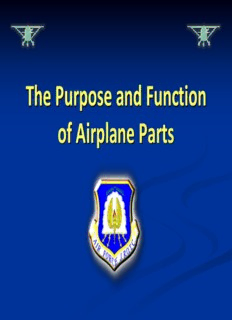
The Purpose and Function of Airplane Parts PDF
Preview The Purpose and Function of Airplane Parts
The Purpose and Function of Airplane Parts Warm-Up Questions CPS Questions 1-2 Chapter 1, Lesson 3 Lesson Overview How the fuselage and wing shape correspond to an aircraft’s mission The types, purpose, and function of airfoil design The role of stabilizers and rudders The positions of flaps, spoilers, and slats on an aircraft How the airflow and airfoil affect flight movement The purpose and function of propellers, turbines, ramjets, and rocket propulsion systems Chapter 1, Lesson 3 Quick Write Write about another time in history when a major event spurred technological progress, and list three inventions that resulted. (Note to teacher: Use “Pick a Student” button in CPS) Chapter 1, Lesson 3 Courtesy of NASA Langley Research Center (NASA-LaRC) The Fuselage The fuselage is the aircraft body Fuselage vary in shape to fit the mission Aircraft rotates around center of gravity inside the fuselage Fuselage must be strong enough to withstand torque Chapter 1, Lesson 3 Courtesy of USAF/CMSgt Gary Emery Wing Position and Parts Wing position depends on aircraft’s mission Main internal parts are spars, ribs and stringers Fuel tanks usually part of wing Reproduced from US Department of Chapter 1, Lesson 3 Transportation/Federal Aviation Administration Wing Size Glider travels slow and has high-aspect wing ratio and long wingspans Glider wings elliptical shaped to reduce drag and result in long, slow flight Greater the aspect area the lower the induced drag and greater the lift F-16 and space shuttle have low-aspect ratio wings Chapter 1, Lesson 3 Wing Angles Dihedral angles give aircraft roll stability and level flight Large commercial airliner wings have dihedral angles Fighter aircraft have anhedral angles Chapter 1, Lesson 3 Modified from NASA/Glenn Research Center Learning Check Questions CPS Questions 3-4 Chapter 1, Lesson 3 Activity 1: All About Wings Complete the matching and short answer activities about wing types, sizes, positions, and angles Chapter 1, Lesson 3
Description: